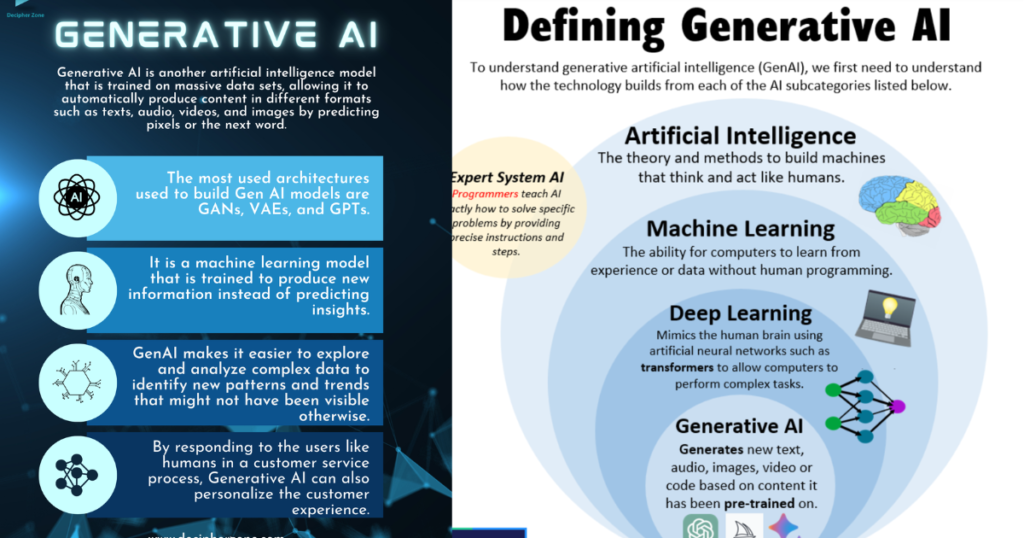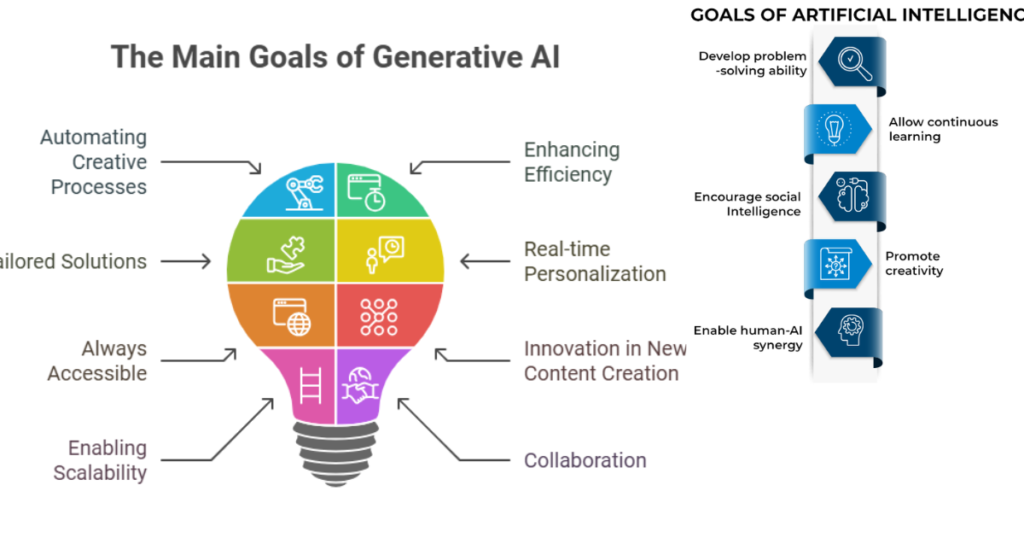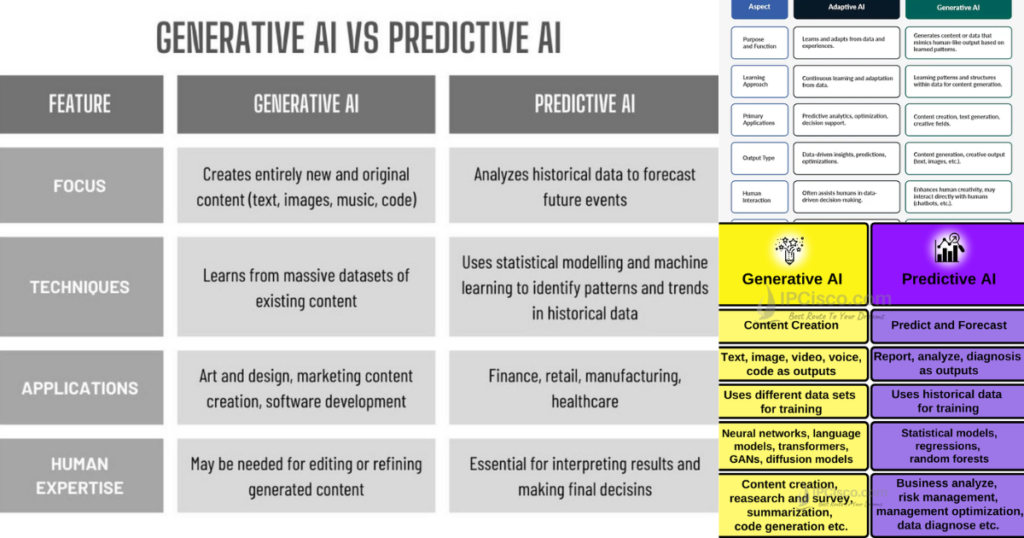
Generative AI is a type of artificial intelligence that creates new content like text, images, or music by learning from existing data. Tools like ChatGPT show how it can produce human-like results quickly and creatively.
What is generative AI?

Generative AI uses deep learning models to produce high-quality content—such as text, images, music, and even code—based on the data it’s trained on. While AI has seen many waves of hype, the release of ChatGPT marked a major shift. OpenAI’s chatbot, built on advanced language models, can write poems, tell jokes, and generate essays that closely resemble human writing. With just a few prompts, it can create everything from Yelp-style love poems to lyrics inspired by Nick Cave.
Previously, generative AI made waves in computer vision—turning selfies into classical paintings or aging faces for fun. Now, the spotlight is on natural language processing, where large language models can adapt to nearly any topic. But it’s not just about words—these models can also understand the structure of code, molecules, and images.
The potential applications are expanding fast. At IBM Research, we’re helping clients use generative AI to speed up software development, discover new drugs, and build reliable chatbots using enterprise data. We’re also using it to generate synthetic data—boosting AI training while preserving privacy and complying with copyright laws.
What is the main goal of generative AI?

Generative AI is an advanced branch of artificial intelligence designed to create new, original content that mimics human creativity. Unlike traditional AI, which focuses on analyzing and reacting to existing data, Generative AI (also known as Gen AI or GenAI) actively produces fresh content—ranging from text and images to music and more.
What is the difference between generative AI and predictive AI?

IGenerative Artificial Intelligence (Gen AI) leverages data to create entirely new content, such as text, images, audio, or code. It identifies patterns in large datasets and uses them to generate original and innovative outputs.
In contrast, Predictive AI analyzes historical data to forecast future events or trends. It’s designed to make accurate predictions based on past behaviors, patterns, and probabilities.
This distinction is why many businesses are increasingly investing in AI solutions. By understanding the strengths of each type—creative generation versus informed prediction—organizations can apply AI more strategically to drive innovation and improve decision-making.
As AI technology continues to advance, clearly differentiating between generative and predictive AI is essential to unlocking their full potential.
What is the key feature of generativeAI?

Generative AI (Gen AI) is reshaping the digital landscape with its unique capabilities. Let’s explore five standout features that make generative AI so powerful and transformative.
Creativity and Originality
One of the most remarkable traits of generative AI is its ability to generate fresh, original content—without direct human instruction. Trained on vast datasets, it identifies patterns and recombines them in imaginative ways.
Example: Ask a Gen AI model to write a story about a pirate teaming up with a robot, and it may craft a never-before-told tale filled with adventure, emotion, and unexpected twists. This inventive ability makes Gen AI a powerful tool for artists, writers, musicians, and creators across industries.
Data Efficiency
Generative AI is highly data-efficient, meaning it can perform well even with limited training data. Unlike traditional AI models that require thousands of labeled examples, Gen AI can learn from smaller datasets and still generate meaningful, high-quality outputs.
Generative AI can synthesize additional examples from limited samples—supporting hypothesis testing, simulations, and drug development without needing large-scale clinical data
Adaptability
Adaptability is yet another essential quality. With little further input, generative AI models can be optimized for a range of tasks after they have been trained. They can be used in a variety of fields, from design to customer service, without having to start from scratch because they understand general data structures and relationships.
For instance, with comparatively little additional training, a generative AI that has been trained on language tasks can be modified to create marketing letters, develop code, or summarize legal papers.
Automation
High-level automation of content production is made possible by generative AI, which lowers operating expenses and manual labor. It puts forth endless effort and generates reliable outcomes on a large scale.
In order to free up human journalists to work on in-depth pieces, news organizations, for example, use generative AI to automate repetitive reporting duties like financial summaries or sports scores. Automation is also used by businesses to boost productivity and efficiency.
Personalization
Personalization is one of the most commercially valuable qualities.Generative AI can offer a more engaging and relevant experience by tailoring content to each user based on their preferences, routines, or past interactions.
In e-commerce, for example, generative AI may provide personalized product descriptions, marketing emails, or chat responses, giving each interaction a distinct feel and significantly raising customer satisfaction and conversion rat
With a clearer understanding of what makes generative AI so powerful—from creativity to automation—let’s now explore how generative AI actually works and the technology behind it.
How is generative AI able to work in health care?

Generative AI in healthcare is a cutting-edge application of artificial intelligence that uses advanced machine learning algorithms to produce synthetic data closely resembling real-world medical information. This data can be used to train AI models, simulate clinical trials, and personalize patient care, all while maintaining patient privacy and enhancing innovation
Generative AI has a wide range of uses in healthcare, from increasing the accuracy of diagnoses to refining treatment plans. Healthcare providers can provide more effective, efficient, and focused care by utilizing this technology, which will ultimately improve patient outcomes and save operating expenses..
Generative AI brings numerous advantages that have the potential to reshape the healthcare landscape:
Improved Patient Outcomes
Generative AI supports clinicians in making more accurate diagnoses and crafting personalized treatment plans tailored to each patient’s unique medical profile. This leads to better-targeted interventions and improved health outcomes.
Enhanced Operational Efficiency
By automating time-consuming administrative tasks—such as data entry, medical coding, and documentation—generative AI allows healthcare professionals to devote more time to direct patient care and critical decision-making.
Greater Patient Engagement
Through personalized health insights and recommendations, generative AI enables patients to become more proactive and informed about their own care, strengthening the patient-provider relationship.
Cost Reduction
Generative AI helps streamline clinical processes and reduce unnecessary tests and procedures. By optimizing workflows and resource utilization, it contributes to substantial cost savings across healthcare systems.
Revolutionizing Healthcare Delivery
With its ability to generate realistic data, support clinical decision-making, and enhance personalization, generative AI holds the promise of revolutionizing healthcare. It paves the way for a more precise, patient-centered, and efficient approach to medical care—transforming the future of health for both providers and patients alike.
Why is Generative AI important?
Generative AI boosts creativity, speeds up content creation, and supports innovation across industries like healthcare, marketing, and software development.
What makes Generative AI more powerful than traditional AI?
Unlike traditional AI that only analyzes data, Generative AI creates new content—mimicking human-like creativity and decision-making.
Can Generative AI work with limited data?
Yes, it is data-efficient and can still produce high-quality results even with smaller datasets by learning patterns and generating new examples.
How does Generative AI improve customer experiences?
It personalized responses, automates tasks like chat support, and delivers content tailored to each user’s preferences or behavior.
What role does Generative AI play in healthcare?
It helps generate synthetic data, personalize treatments, automate administrative tasks, and ultimately improve patient outcomes and reduce costs.
Conclusion
Generative AI is rapidly emerging as one of the most transformative technologies of our time. With its ability to create new, original content, mimic complex data patterns, and adapt across industries, it is reshaping how we work, create, and solve problems
. From healthcare and education to marketing and entertainment, generative AI is driving innovation, improving efficiency, and enabling deeper personalization.
As this technology continues to evolve, it’s crucial for individuals and organizations to understand its capabilities, benefits, and responsible use. By leveraging generative AI thoughtfully, we can unlock new levels of creativity, productivity, and value—ushering in a smarter, more connected future.



